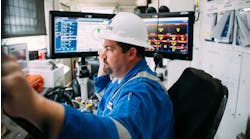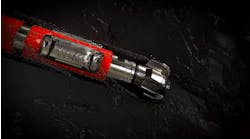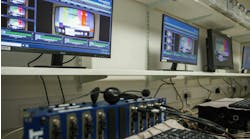Air filtration system helps improve gas turbine performance on BP’s Clair platform
Graeme Turnbull, AAF International
The offshore oil and gas industry has long focused on the importance of maintaining gas turbine engines, but a critical issue that often escapes attention is air filtration systems. Located at the front of the gas turbine, these systems can enhance gas turbine performance and availability, while promoting better compressor cleanliness and long-term part integrity. As seen on BP’s Clair platform in the North Sea, optimum air filtration systems can unlock considerable financial, operational, and environmental benefits.
Gas turbines are essential to the production of oil and gas, running both mechanical drive and power generation applications on offshore platforms. However, they are repeatedly exposed to the most arduous atmospheric conditions.
Air in the offshore environment contains numerous airborne particles that have the potential to harm gas turbines. These include water droplets, sea salt aerosols, salt in solution and sub-micron particulate, as well as industrial airborne particulates from burnt and unburnt hydrocarbons, drilling activities, mud burn, and grit blast.
Cooling passages on the turbine blades in the hot end of the gas turbine must remain free of contamination and clear of blockages. If they are not suitably protected from the elements offshore and become blocked this will result in fatigue and cracking, causing significant damage, and incurring high costs and downtime for repair. When running with sour fuel, the components within the turbine section are also exposed to accelerated hot end corrosion. This phenomenon results from the combustion of sour fuel gas, which is rich in hydrogen sulphide and reacts with the salt from the intake air.
Limited protection
When it comes to protecting gas turbines from offshore air, and all that is contained within, air filtration systems play a critical role, operating on the front line of defense. Currently, around 85% of offshore gas turbines are protected by small high velocity filtration systems that use low efficiency filter bags. These only provide protection against coarse particles, and fail to capture sub-micron particles offshore. It is worth noting that the air quality at platform level is significantly different to sea level. At the height of an offshore platform the majority of particles in the air are sub-micron in size. The vast majority of particles of this size will pass through high velocity filter bags, in fact only 5% will be captured. This can lead to lost production revenue, unplanned gas turbine shutdowns, reduced component and engine life, premature engine failure, and low turbine compression efficiency and high CO2 emissions; especially unwanted given today’s current market dynamics and the low price of oil. By contrast, high efficiency particulate air filter (EPA) 12 technology captures 99.95% of sub-micron particles. This protects and enhances the performance of expensive gas turbine components.
As operators have become aware of the benefits of EPA E12 air intake filtration, there has been a push to upgrade existing high velocity units installed offshore. However, traditional EPA E12 filtration technologies - with much larger equipment envelopes - have necessitated that the air intake housing is replaced in its entirety. This increases foundation loads and incurs significant costs and down time. However, there is another route, using a new EPA E12 system which provides all the associated benefits of EPA E12 air filtration, but can be quickly and seamlessly installed within the existing high velocity air intake filtration system.
BP’s Clair platform
BP’s Clair platform operates three Titan 130 gas turbines (GTs 1, 2 and 3) employed in power generation application to provide power to the asset. Each gas turbine was experiencing compressor blade fouling, corrosion and erosion, as well as turbine section hot gas path corrosion. Operationally, this resulted in poor engine reliability, reduced availability and premature engine overhaul and/or replacement. All of which severely impeded the long-term strategic planning for the platform for both production and maintenance.
Eventually, the poor filtration provided by the high velocity bag system resulted in a catastrophic failure of GT2 after 12,000 operating hours, which equated to only one-third of the engine design life. The root cause of the failure being inlet guide vane seizure and in turn compressor section imbalance and ultimately blade liberation. This resulted in irreparable damage and a new replacement engine was required, incurring unplanned long-term shutdown and significant unbudgeted costs.
BP was aware that AAF International was in the final stages of developing a new EPA E12 high velocity filtration solution. Critically this new design could be installed within an existing high velocity housing with no penalty in differential pressure (dP), therefore negating the need for a larger housing replacement. Because of this failure on GT2, BP was expediting the GT original equipment manufacturer (OEM) for fasttrack delivery of a replacement engine and approached AAF to determine if this new technology (N-hance) could be urgently deployed in a field trial as a technology collaboration initiative.
Thanks to a longstanding relationship between the two companies, BP was able and confident to pilot AAF’s N-hance technology. The N-hance filters and conversion parts were delivered to the operator within five weeks, and commissioned along with the new GT2 engine on the Clair platform in February 2017.
The pilot delivered excellent results. There was an increase in engine availability resulting from a reduction in unplanned downtime and shortened shutdown periods. There was also a decrease in CO2 emissions improving sustainability, as well as retained power output (compressor efficiency) and heat rate. Critically, BP has also eliminated the risk of potential GT failure due to corrosion at just one-third of design life.
Commenting on the project, BP’s asset team said: “The upgrade project has enabled improved reliability, cost savings and will feed into the reformation of outdated air filtration standards as well as playing a part in helping to achieve offshore asset efficiency of 90%.”
New mechanisms to drive technology adoption
EPA E12 air filtration is currently available within low velocity systems and already in use on assets owned by super majors. However, few operators are aware that EPA E12 filtration is now supported within high velocity systems. This is partially due to the fact there needs to be significantly more support for the widespread adoption of the technology used on the Clair platform. This includes the adoption of EPA E12:EN1822 standards within OEM offshore turbine specifications to extend the life of all new gas turbines operating in the offshore environment and provide the operator with the added benefit of a small and lightweight filter housing in comparison to the traditional low velocity large E12 filter housings. Operators also have their part to play and need to question why they are repeatedly offered low efficiency filter bags for high velocity systems. The accepted norms of poor air filtration in offshore environments can be redefined, and operators can benefit from the improved technology. Immediately, the result will be to eliminate frequent water washing of the gas turbine, increasing production efficiency while at the same time providing a longer operational life of the gas turbine. Furthermore, a sustained effort is needed to communicate the evolution in filtration performance and demonstrate the findings, which support the use of new proven EPA E12 technologies.
Collectively if adopted by the offshore oil and gas industry, these measures trigger a new “front end” approach to gas turbine reliability and availability, which is beginning to gain momentum in some areas of the sector. With cost control and environmental improvements, such as CO₂ reduction now more critical than ever, taking the necessary steps to address current technology adoption should be delayed no further. •



